Greetings and Best Wishes,
(The FOIA below was inspired by Donald J Netolitzky, a former "virus" researcher who currently acts as Alberta Court of King’s Bench lawyer, yet proudly admits that he is “not really interested in law, legal theory, etc.” Donald regularly churns out wildly biased hit-pieces about people who don't bow to bar association extortionists or play along with imaginary "virus" fear-mongering/ terrorism.
Before he recently ran from questions about “SARS-COV-2” and the authority of “the state”, Donald cited a 2000 study on “western equine encephalitis virus” in which he fraudulently, or delusionally, claimed to have “sequenced the virus”.)
January 6, 2023:
FOIA request filed with the U.S. Centers for Disease Control and Prevention (CDC) and Agency for Toxic Substances and Disease Registry (ATSDR) seeking all studies/reports in their possession, custody or control that:
scientifically prove/evidence the existence of the alleged western equine encephalitis virus or any other alleged encephalitis virus (showing that the alleged particle exists and causes the dis-ease that it's alleged to cause)
and if they have no such studies, all studies that:
describe purification of particles that are alleged to be said virus(es), directly from bodily fluid/tissue/excrement of so-called “hosts”, with purification confirmed via EM imaging.
As always, I emphasized that I seek all such records held by these agencies regardless of whether they were authored by someone working there or elsewhere, and that if such records are held and are already publicly available, I require citations.
January 8, 2024:
Request acknowledged by Roger Andoh acting as CDC/ATSDR FOIA Officer, Office of the Chief Operating Officer.
January 24, 2024:
Roger Andoh acting as CDC/ATSDR FOIA Officer, Office of the Chief Operating Officer confessed that the “experts” at CDC and ATSDR have no such records.
“A search of our records failed to reveal any documents pertaining to your request.”
Roger then claimed that the “science” had been settled before the CDC became an agency, presumably to explain why the “experts” at CDC don’t have a copy of said alleged “science”. (Why would anyone need a copy to read when the science was already settled?)
“The principal science behind the discovery and description of western equine encephalitis virus occurred before CDC became an agency.”
Roger then cited a “key reference” that presumably contains the “principal science” (that no one at the CDC ever needed a copy of since the “science” was already settled) showing the existence of the alleged “western equine encephalitis virus”:
“A key reference is listed below.
Author(s) : Kelser, R. A.
Journal article : Science (Washington) 1937 Vol.85 No.2198 pp.178 p ref.1
Abstract : In experiments in 1936, Aedes taeniorhynchus, Wied., transmitted the western type of equine encephalomyelitis from one guineapig to another, but did not transmit the eastern type. In one of a number of positive experiments, a single mosquito feeding only once produced the disease and death of the guineapig in five days.”
The “key reference” cited by Roger was published by the American Association for the Advancement of Science in 1937.
According to the abstract in Roger’s confession letter, in 1936 a black salt marsh mosquito (“Aedes taeniorhynchus, Wied”) was experimentally shown to transmit the western type of equine encephalomyelitis from one guineapig to another but failed to transmit the eastern type.
Below (and here) is the “principal science” cited by Roger, in its entirety, authored by R. A. Kelser of the Army Medical Research Board, Ancon, Canal Zone.
As you can see, the “principal science” is not a scientific study with a detailed description of the methodologies employed and the results obtained. It’s just a brief note less than half a page in length, vaguely claiming that 6 or maybe 7 different species of mosquitoes had been shown to transmit equine encephalomyelitis among guineapigs.
It contains no hint of how, or whether, any specific illness-causing agent (“virus”) was actually identified and shown via valid controlled experiments to do anything.
It contains no description of any purported “virus” or causal agent, at all.
And like many “germ” studies, it contains no hint at controls having been implemented in any experiment whatsoever.
But according to the CDC this is the “principal science” establishing the existence of “western equine encephalitis virus” and transmission of the dis-ease.
One other thing:
In Roger’s reference to Kelser’s “principal science” allegedly showing that Aedes taeniorhynchus transmits equine encephalomyelitis among guineapigs, he mentioned “ref. 1” (as highlighted in the screenshot below).
This apparently refers to another publication, which Kelser had cited in his <.5 page “principal science” (as is also highlighted in the screenshot below). This other publication was also authored by Kelser, in 1933, and allegedly showed that Aedes aegypti also transmits equine encephalomyelitis, allegedly via “the virus”.
If anyone is able to find a full-text copy of this study, please share it with me as I’ve been unable to find one. I will add an update here if a copy is found.
Communications and the principal pseudoscience:
https://www.fluoridefreepeel.ca/wp-content/uploads/2024/02/CDC-Encephalitis-virus-PACKAGE-redacted-2024.pdf
ADDENDUM - February 15, 2024
"V." has kindly found and forwarded the 1933 study cited by Kelser; see page 767 in the archived journal here:
https://babel.hathitrust.org/cgi/pt?id=uc1.b2954946&seq=715&q1=kelser
or for faster access go here:
https://www.fluoridefreepeel.ca/wp-content/uploads/2024/02/1933-Kelser-equine-encephalitis-study.pdf
It is 4.5 vague pages in length, described as a "brief summary" promising a full, detailed treatise at a later date.
In it, "Major R. A. Kelser, V. C., U. S. Army, Army Medical School, Army Medical Center" made no mention whatsoever of controls and gave no description of the living conditions for the animals.
According to Kelser, the Chief of the Division of Pathology, U. S. Bureau of Animal Industry obtained something from a horse with encephalomyelitis, labelled it "the virus" and gave it to Kelser or whoever carried out this research.
The Army Medical School supplied mosquitoes (Aedes aegypti) that had been kept under "laboratory conditions" for the previous ~7 years.
The researchers "artificially inoculated" (those are Kelser's words, see p 771) two guinea pigs intracutaneously with the so-called "virus", and a third guinea pig both intracutaneously and intracerebrally.
Over the next week, the researchers allowed hundreds of mosquitoes to feed on the "artificially inoculated" guinea pigs.
By the 5th day, the guinea pig that had been "artificially inoculated" intracutaneously and intracerebrally was dead; 2 days later the other guinea pigs were also dead.
The searchers then killed 2 mosquitoes that had fed on the tortured guinea pigs, ground them up with some physiological saline solution and injected those foreign proteins etc. intracutaneously into another guinea pig (which had not previously been "artificially inoculated"). It died of encephalomyelitis a little over a week later.
The searchers then gave 48 of the mosquitoes, which by this point hadn't eaten for 6 days, another guinea pig to feed on and it too died of encephalomyelitis 8 days later.
After another 6 days without feeding, the researchers gave these same mosquitoes another guinea pig to feed on. It died of encephalomyelitis 9 days later.
After another 6 days without feeding, the researchers gave these same mosquitoes another 2 guinea pigs to feed on and they both died with encephalomyelitis 6 days later.
The researchers then gave another batch of hungry mosquitoes (that had also previously fed on the "artificially inoculated", tortured and now-dead guinea pigs) a live guinea pig to feed on and it died with encephalomyelitis 6 days later.
The researchers then took some of that guinea pig's brain, emulsified it and "artificially inoculated" it intracutaneously into 2 other guinea pigs, which both died with encephalomyelitis 7 days later.
And so on... until the researchers obtained a horse. They exposed the horse to 7 groups of hungry mosquitoes over a 16 day period. It developed "the classical symptoms of encephalomyelitis" and died within a month after the exposures began.
This is not rigorous or logical or scientific evidence of anything. It’s useless animal torture.
Kelser's "brief summary" does not mention any controls having been implemented and it does describe unnatural, invalid exposure routes.
It does not demonstrate that equine encephalomyelitis spreads in nature, and it most certainly did not identify any specific potential causal agent - let alone a “virus” by today’s standards: a submicroscopic, replication-competent intracellular obligate parasite that causes a contagious illness via natural exposure routes.
In another of Kelser’s useless exercises in animal torture from 1937, he described the specific method he used when feeding “infected” guinea pigs to mosquitoes (that “supposedly” ended up infected with the never-shown-to-exist “virus”).
Related
Dr. Mark Bailey, Dr. Kevin Corbett & Dr Bruce Scott on The Sonia Poulton Show
https://tntvideo.podbean.com/e/dr-mark-bailey-dr-kevin-corbett-dr-bruce-scott-on-the-sonia-poulton-show-29-january-2024/
COVID LIES prove that modern VIROLOGY is PSEUDOSCIENCE — Alec Zeck and Mike Winner with Mike Adams, the Health Ranger
https://rumble.com/v4aq649-bbn-feb-1-2024-covid-lies-prove-that-modern-virology-is-pseudoscience.html
Measles Magic Pulling back the curtain — Mike Stone, viroLIEgy
Viruses Don't Exist and Why It Matters — Dr Sam Bailey
New Podcast: COVID, the missing evidence — Jon Rappoport
Pharmaceutical Fraud and the Discovery of "Rotavirus” — Dr Sam Bailey
Former Pfizer VP admits: no virus, no contagion, no future pandemics - Dr. Mike Yeadon
https://www.bitchute.com/video/q0stvt0wFbeV/
Yet more media manipulation? — Dawn Lester
Lab Leak: An Elaborate Misdirection? — HFDF Team
https://healthfreedomdefense.org/lab-leak-an-elaborate-misdirection/
FOIs Summary
Freedom of Information Responses reveal that health/science institutions around the world (220 and counting!) have no record of SARS-COV-2 (the alleged convid virus) isolation/purification, anywhere, ever:
https://www.fluoridefreepeel.ca/fois-reveal-that-health-science-institutions-around-the-world-have-no-record-of-sars-cov-2-isolation-purification/
Excel file listing 220 institutions:
https://www.fluoridefreepeel.ca/wp-content/uploads/2023/11/Institution-list-for-website.xls
FOI responses re other imaginary viruses (HIV, avian influenza, HPV, Influenza, Measles, etc., etc., etc.):
https://www.fluoridefreepeel.ca/fois-reveal-that-health-science-institutions-have-no-record-of-any-virus-having-been-isolated-purified-virology-isnt-a-science/
FOIs re secretive and unscientifically "mock infected" cells (aka invalid controls) and fabricated "virus genomes":
https://www.fluoridefreepeel.ca/do-virologists-perform-valid-control-experiments-is-virology-a-science/
3000+ pages of "virus" FOIs (updated as of December 31, 2022) in 8 compilation pdfs, and my notarized declaration re the anti-scientific nature of virology:
https://tinyurl.com/IsolationFOIs
Failed freedom of Information responses re contagion:
https://www.fluoridefreepeel.ca/freedom-of-information-responses-re-contagion/
Do health and science institutions have studies proving that bacteria CAUSE disease?
https://www.fluoridefreepeel.ca/do-health-authorities-have-studies-proving-that-bacteria-cause-disease-lets-find-out-via-freedom-of-information/
Because "they" (HIV, influenza virus, HPV, measles virus, etc., etc., etc.) have never been shown to exist, clearly don't exist and virology isn't a science.
For truth, freedom and sanity,
Christine


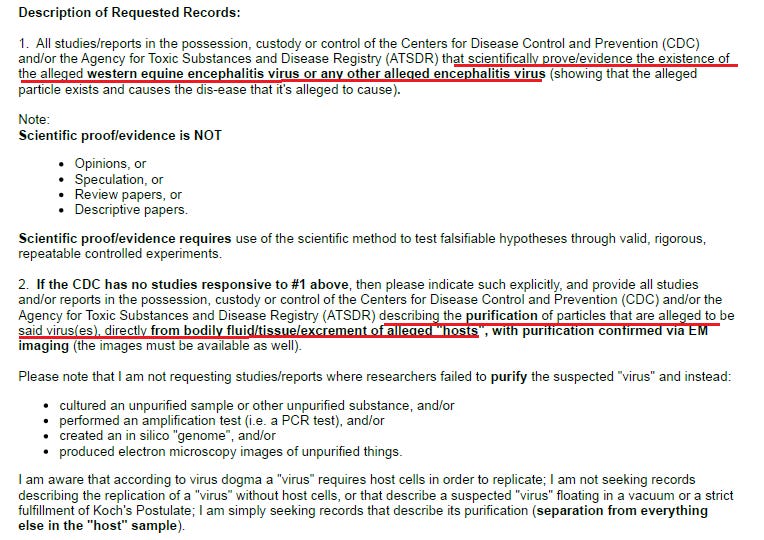


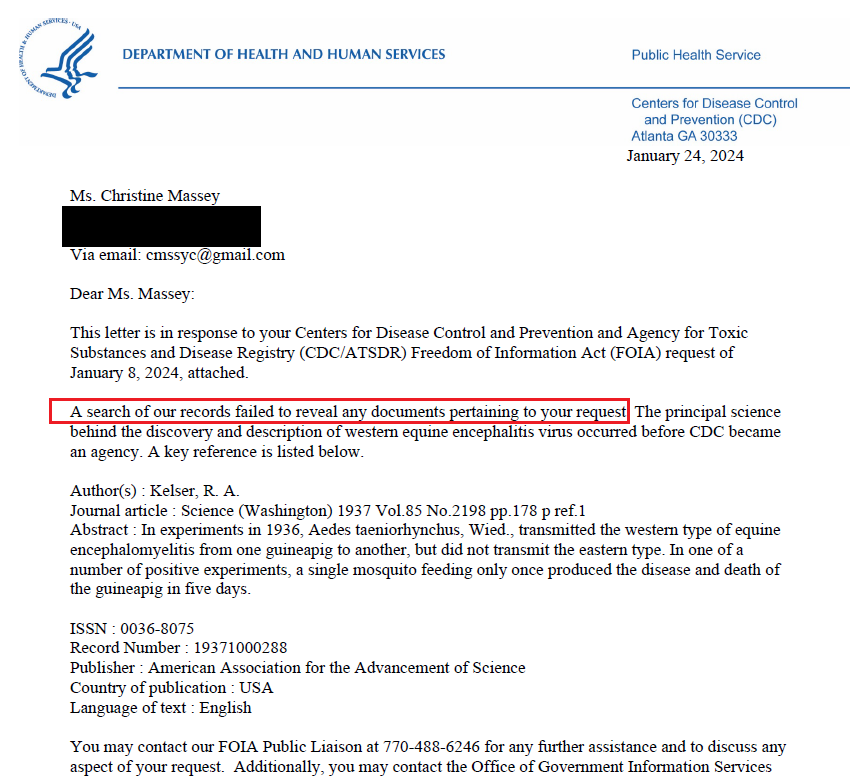
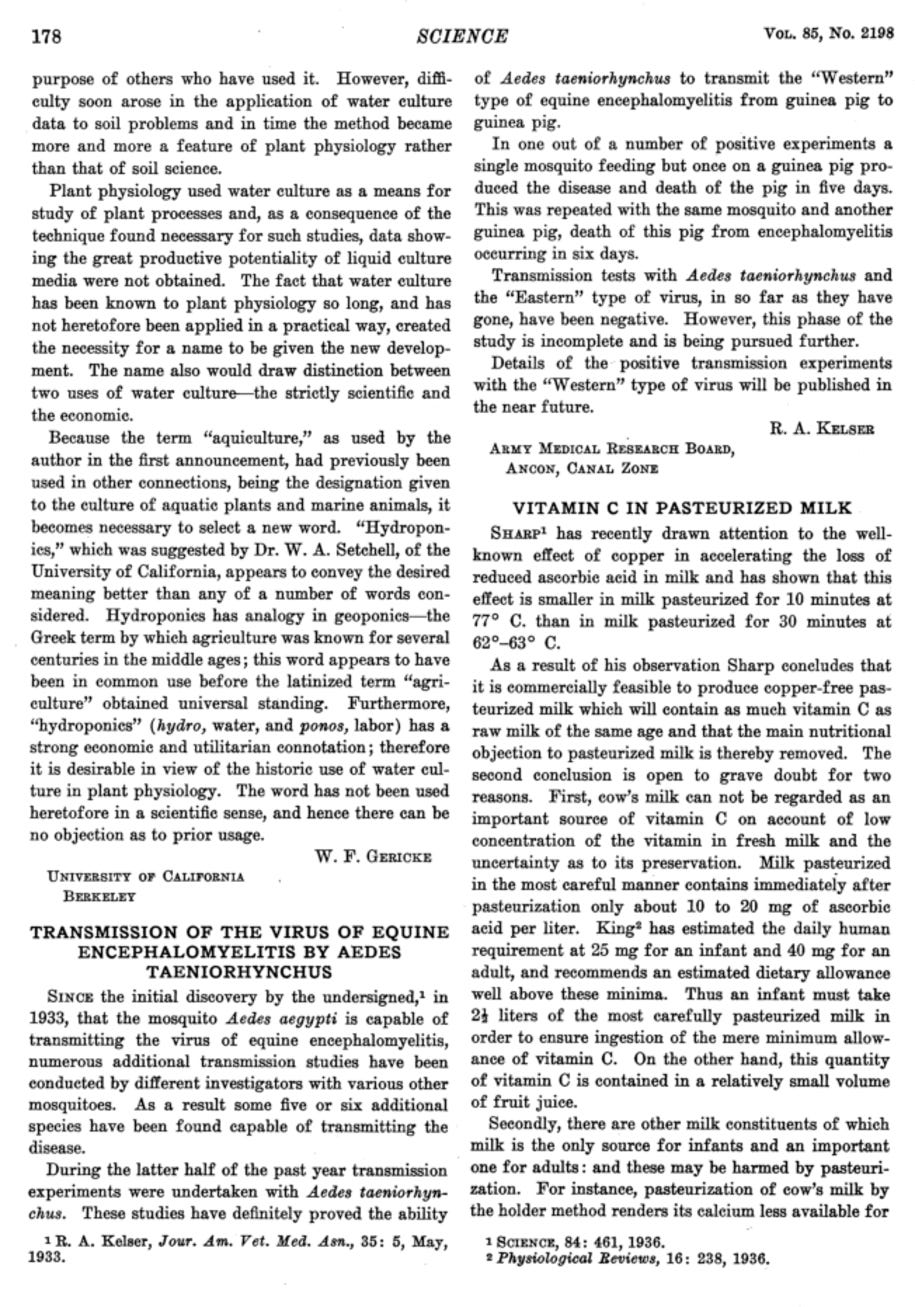
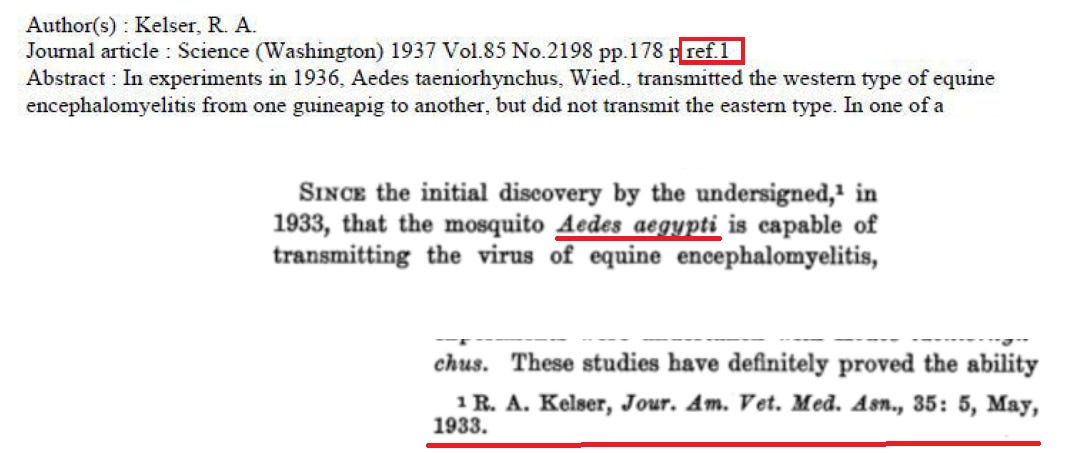
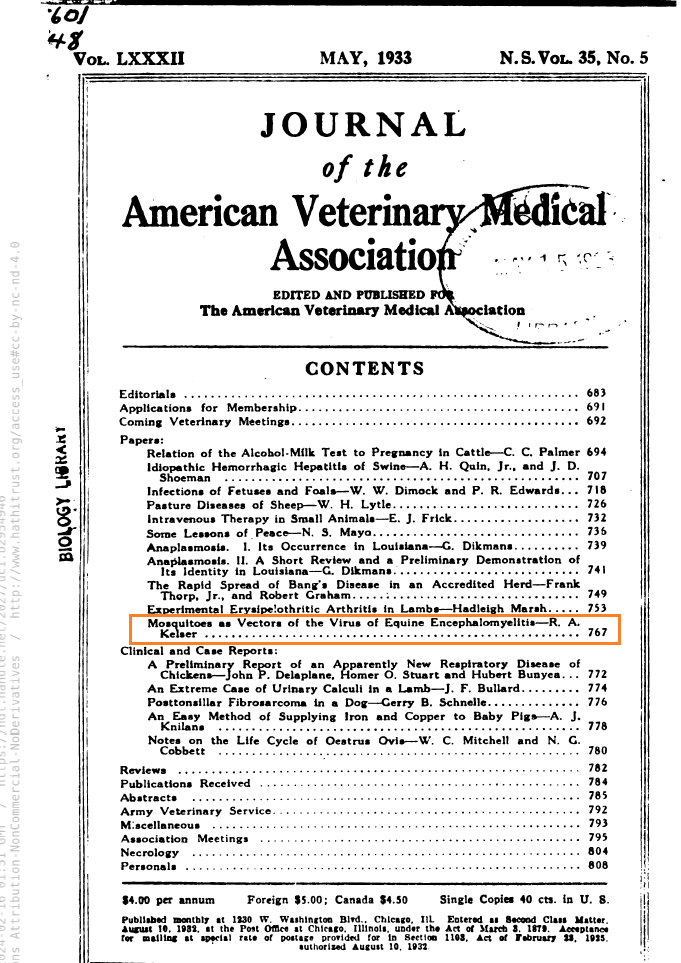





"V." has kindly found and sent the 1933 study cited by Kelser; see pg 767 in the journal here - it takes a long time to download, so also see the easier link on my website below:
https://babel.hathitrust.org/cgi/pt?id=uc1.b2954946&seq=715&q1=kelser
https://www.fluoridefreepeel.ca/wp-content/uploads/2024/02/1933-Kelser-equine-encephalitis-study.pdf
It is 4.5 vague pages in length, described as a "brief summary" promising a full, detailed treatise at a later date.
In it, "Major R. A. Kelser, V. C., U. S. Army, Army Medical School, Army Medical Center" made no mention whatsoever of controls and gave no description whatsoever of the living conditions for the animals.
According to Kelser, the Chief of the Division of Pathology, U. S. Bureau of Animal Industry obtained something from a horse with encephalomyelitis, labelled it "the virus" and gave it to the researchers.
The Army Medical School supplied mosquitoes (Aedes aegypti) that had been kept under "laboratory conditions" for the previous ~7 years.
The researchers "artificially inoculated" (those are Kelser's words on p 771) 2 guinea pigs intracutaneously with the so-called "virus", and a third guinea pig both intracutaneously and intracerebrally.
Over the next week, the researchers allowed hundreds of mosquitoes to feed on the "artificially inoculated" guinea pigs.
By the 5th day, the guinea pig that had been "artificially inoculated" intracutaneously and intracerebrally was dead; 2 days later the other guinea pigs were also dead.
The searchers then killed 2 mosquitoes that had fed on the tortured guinea pigs, ground them up with some physiological saline solution and injected those foreign proteins etc. intracutaneously into another guinea pig (which had not previously been "artificially inoculated"). It died of encephalomyelitis a little over a week later.
The searchers then gave 48 of the mosquitoes, which by this point hadn't eaten for 6 days, another guinea pig to feed on and it too died of encephalomyelitis 8 days later.
After another 6 days without feeding, the researchers gave these same mosquitoes another guinea pig to feed on. It died of encephalomyelitis 9 days later.
After another 6 days without feeding, the researchers gave these same mosquitoes another 2 guinea pigs to feed on and they both died with encephalomyelitis 6 days later.
The researchers then gave another batch of hungry mosquitoes (that had also previously fed on the "artificially inoculated" and now-dead guinea pigs) a live guinea pig to feed on and it died with encephalomyelitis 6 days later.
The researchers then took some of that guinea pig's brain, emulsified it and "artificially inoculated" it intracutaneously into 2 other guinea pigs, which both died with encephalomyelitis 7 days later.
And so on... until the researchers obtained a horse. They exposed the horse to 7 groups of hungry mosquitoes over a 16 day period. It developed "the classical symptoms of encephalomyelitis" and died within a month after the exposures began.
This is not rigorous or logical or scientific evidence of anything.
Kelser's "brief summary" does not mention any controls having been implemented and it does describe unnatural, invalid exposure routes.
It does not demonstrate that equine encephalomyelitis spreads in nature, and it most certainly did not identify any specific potential causal agent... let alone a submicroscopic, replication-competent intracellular obligate parasite (a "virus").
Hello Christne. Can you point me to any FOIAs on SV40 virus?
Thanks